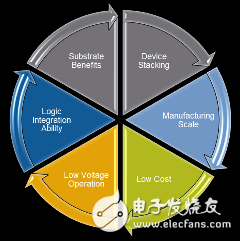Today's smartphones and tablets are equipped with radio frequency (RF) front-end modules (FEMs), which typically include power amplifiers (PAs), switches, tunable capacitors, and filters. Technologies such as RF-on-insulator (RF SOI) enable mobile devices to adjust and acquire cellular signals—providing a robust, clear network connection to wireless devices in a wider area. The mobile market's quest for RF SOI continues to heat up because it achieves low insertion loss at a high cost performance and achieves low harmonics and high linearity over a wide frequency range. RF SOI is a win-win technology choice that improves the performance and data transfer speed of smartphones and tablets, and is expected to play a key role in the Internet of Things. For RF chip manufacturers, RF SOI brings the benefits of chip design and integration to the RF front-end design. This technology is the best choice for RF front-end module solutions at a lower cost than other expensive technologies that lack scale and integration capabilities. In addition, RF SOI provides designers with design flexibility by integrating multiple RF components onto a single chip without taking up valuable space on the board. This integration reduces the number of chips and reduces the size of mobile applications, helping handset manufacturers to design simpler RF modules with the advanced features customers expect. Compared with other technologies, using RF SOI technology in RF front-end applications will bring equal or better linearity and lower insertion loss to mobile devices, which means longer battery life, reduced phone drop, and improved data transmission. rate. With an innovative RF architecture, SOI delivers powerful performance for innovative RF front ends and WAN RFSOCs More good news will make RF market participants excited. The unique properties and capabilities of technologies such as FD-SOI will drive RF circuit innovation, and silicon technology will achieve an unprecedented level of integration. FDSOI's low voltage operation and good biasing are key. The dynamic control of Vdd and good bias technology not only reduce overall power consumption, but also optimize RF line operation, which is difficult to match with bulk silicon technology. Another advantage of this technology when designing complex system-on-chip (SoC) is the integration of versatility, the ability to reduce size and simplify packaging, and more cost-effective; in terms of energy consumption, it can improve the efficiency of IoT applications. Therefore, it is very suitable for the economic needs of the market and can cope with the ever-changing network challenges in real time. While these emerging standards (such as 5G networks) will take several years to mature, we have seen that the advantages of new technologies such as FDSOI/RFSOI in addressing the challenges of implementing high-speed/bandwidth systems with low power consumption have attracted widespread attention. . Undoubtedly, our network demand will continue to rise, the basic communication network will be more important than ever, and the market can't wait to get higher speed. The horn of the mobile world has already sounded, and for equipment manufacturers and component designers, it is now the best time to take full advantage of the design flexibility, power and supply (production guarantee) of RF SOI technology. Product features: Generator TR GFCI UL,Ground Fault Circuit Interrupter TR,Generator TR GFCI UL outlet,Ground Fault Circuit Interrupter TR outlet Hoojet Electric Appliance Co.,Ltd , https://www.hoojetgfci.com
â– Good heat dissipation
--Blade design of copper alloy contacts,good conductivity
â– Super high impact resistance and thermal stability
--Cover pans are made of high quality polycarbonate
â– Chemical corrosion resistance
-- Fingerprint-resistant zinc plated mounting brackets
â– Grounding
--One-piece grounding design,No Load-Weather resistance